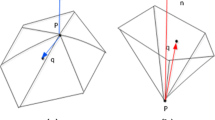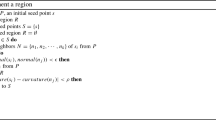Abstract
Automated approaches for the conversion of multiple overlapped three-dimensional (3D) point clouds into an integrated surface shape measurement in the form of a complete polygon surface are important in the general field of reverse engineering. Traditionally, the conversion process is achieved in a semi-automated manner that requires extensive user interaction. In this work, automated methods for point set registration are developed and experimentally validated using polygon surface reconstruction to represent raw, 3D point clouds obtained from non-contacting measurement systems. Using local differential properties extracted from the polygon surface representation for a measurement data set, a robust sculpture surface feature-matching method is described for automatically obtaining the initial orientation and mismatch estimates for each overlapped data set. Using both simulated and measured experimental data to quantify the performance of the method, it is shown that differential local surface features are appropriate metrics for identifying common features and initializing the relative positions of individual point clouds, thereby providing the basis for automating the registration and integration processes while improving the speed of the surface distance minimization method developed for the initial registration process.
Similar content being viewed by others
References
Helm, J., “Use of Three-dimensional Digital Image Correlation for the Experimental Characterization of Buckling in Large, Thin, 2024-T3 Aluminum, Middle-Crack Tension Specimens,” Ph.D. Thesis, University of South Carolina (1999)
Helm, J., McNeill, S., andSutton, M., “Improved Three-dimensional Image Correlation for Surface Displacement Measurement,”Optical Engineering,35(7),1911–1920 (1996).
Milroy, M., Weir, D., Bradley, C., andVickers, G., “Automated Laser Scanning Based on Orthogonal Cross Section,”Machine Vision and Applications 9(3),106–118 (1996).
Varady, T., Martin, R., andCox, J. “Reverse Engineering of Geometric Models—An Introduction,”Computer-Aided Design,29 (4),255–268 (1997).
Bern, M. and Eppstein, D., “Mesh Generation and Optimal Triangulation,” Technical Report P92-00047. Xerox Palo Alto Research Center, March (1992).
Lee, D. andSchachter, B., “Two Algorithms for Constructing The Delaunay Triangulation,”International Journal of Computer and Information Science,9(3),219–242 (1980).
Li, N., Cheng, P., Sutton, M., McNeill, S., andChao, Y., “Accurate Reconstruction of Surface Profile Data Sets for Reverse Engineering,” EXPERIMENTAL MECHANICS,41 (sn1), 77–83 (2001).
Besl, P. andJain, R., “Invariant Surface Characteristics for 3D Object Recognition in Range Images,”Computer Vision, Graphics, and Image Processing,33(1),33–80 (1986).
Chen, C., Hung, Y., andCheng, J., “RANSAC-based DARCES: A New Approach to Fast Automatic Registration of Partially Overlapping Range Images,”IEEE Transactions on Pattern Analysis and Machine Intelligence,21(11),1229–1234 (1999).
Flynn, P. and Jain, A., “On Reliable Curvature Estimation,” Proceedings of IEEE Conference on computer Vision and Pattern Recognition, San Diego, CA, June, 110–116 (1989).
Hoff, W. andAhuja, N., “Surfaces from Stereo: Integrating Feature Matching, Disparity Estimation and Contour Detection,”IEEE Transactions on Pattern Analysis and Machine Intelligence,11(2),121–136 (1989).
Kamgar-Parsi, B., Jones, J., and Rosenfeld, A., “Registration of Multiple Overlapping Range Images: Scenes without Distinctive Features,” Proceedings of IEEE Conference on Computer Vision and Pattern Recognition, San Diego, CA, June, 282–290 (1989).
Parvin, B. andMedioni, G., “Adaptive Multiscale Feature Extraction from Range Data,”Computer Vision, Graphics, and Image Processing.45(3),346–356 (1989).
Sato, J. andCipolla, R. “Quasi-invariant Parametrizations and Matching of Curves in Images,”International Journal of Computer Vision 28(2),117–136 (1998).
Wada, N., Toriyama, H., Tanaka, H., and Kishino, F., “Reconstruction of an Object Shape from Multiple Incomplete Range Point Sets Using Convex Hulls,” Proceedings of Computer Graphics International '93, Lausanne, Switzerland, June, 193–203 (1993).
Zhang, Z., “Iterative Point Matching for Registration of Free-Form Curves,” Research Report 1658, France National Institute of Research on Information and Automation (1992).
Thirion, J., “New Feature Points Based on Geometric Invariants for 3D Image Registration,” Research Report 1901, France National Institute of Research on Information and Automation (1993).
Besl, P. andMckay, N., “A Method of Registration of 3D Shapes,”IEEE Transactions on Pattern Analysis and Machine Intelligence,14(2),239–256 (1992).
Chen, Y., andMedioni, G., “Object Modeling by Registration of Multiple Range Images,”Image and Vision Computing,10(3),83–89 (1992).
Turk, G. and Levoy, M., “Zippered Polygon Meshes from Range Images,” Computer Graphics Proceedings, Annual Conference Series 1994, August, 311–318 (1994).
Sharp, G., Lee, S., andWehe, D., “ICP Registration Using Invariant Features,”IEEE Transactions on Pattern Analysis and Machine Intelligence,24(1),90–102 (2002).
Sutton, M., Zhao, W., Scheier, H., McNeill, S., andChao, Y., “Development and Assessment of a Single Image Fringe Projection Method for Dynamic Applications. EXPERIMENTAL MECHANICS,41(3),205–217 (2001).
Bailey, M., “Manufacturing Isovolumes,” Proceedings of the International Workshop on Volume Graphics, Swansea, UK, March, 133–146 (1999).
Hummel, R. andZucker, S., “On the Foundations of Relaxation Labeling Processes,”IEEE Transactions on Pattern Analysis and Machine Intelligence,5(3),267–287 (1983).
Rosenfeld, A., Hummel, R., andZucker, S., “Scene Labeling by Relaxation Operations,”IEEE Transactions on Systems, Man, and Cybernetics,6(6),420–433 (1976).
McNeill, S., Sutton, M., Miao, Z., andMa, J., “Measurement of Surface Profile Using Digital Image Correlation,”EXPERIMENTAL MECHANICS,37(1),13–21 (1997).
Author information
Authors and Affiliations
Rights and permissions
About this article
Cite this article
Li, N., Cheng, P., Sutton, M.A. et al. Three-dimensional point cloud registration by matching surface features with relaxation labeling method. Experimental Mechanics 45, 71–82 (2005). https://doi.org/10.1007/BF02428992
Received:
Accepted:
Issue Date:
DOI: https://doi.org/10.1007/BF02428992




